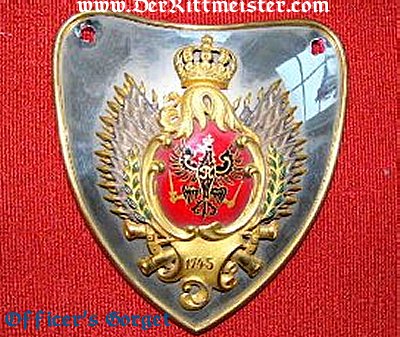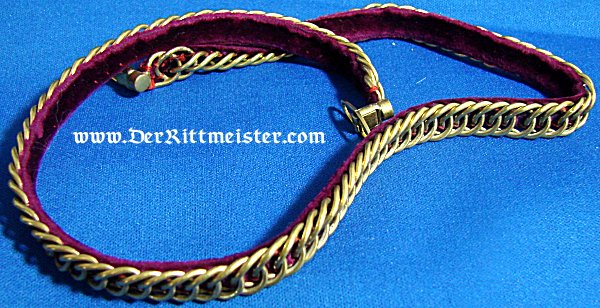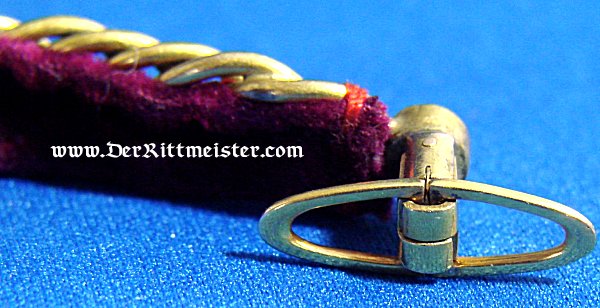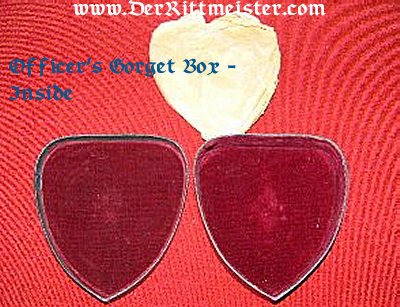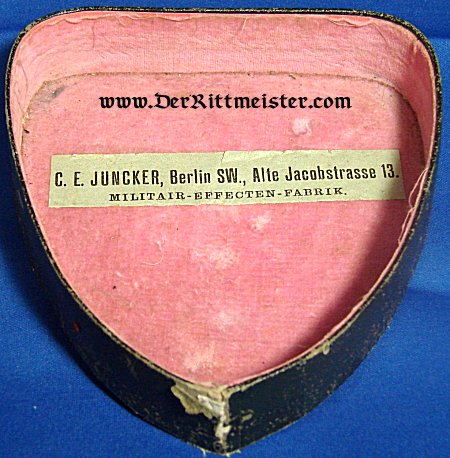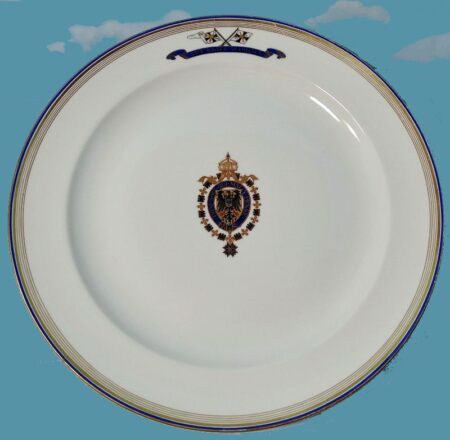Description
Today we are offering Kaiserin Auguste Viktoria’s ringkragen (gorget) as Regimental Chef of Küraßier-Regiment Königin (Pommersches) Nr 2. Kaiserin Auguste Viktoria (1858-1921) was Kaiser Wilhelm II of Germany’s wife. She was born in Schleswig-Holstein. She married Kronprinz Wilhelm (later Kaiser Wilhelm II) in 1881. She bore him an heir in 1882, who was also to be a Kronprinz Wilhelm. This lad never achieved Germany’s throne, since the monarchy fell in 1918. He instead became a “Pretender,” when his father died in 1941. Auguste Viktoria gave the Kaiser a total of six sons and one daughter. She worshiped her husband and he adored her. They were very close. When Wilhelm II abdicated his throne in 1918, she joined him in exile to the Netherlands at Haus Doorn (Huis Doorn). This is where she died in 1921. Her body was returned to Germany, where it was buried at Berlin’s Neues Palais (New Palace). The Kaiser was not afforded the same privilege. When he died in 1941, he was buried at Haus Doorn, where he remains today in a special crypt on the grounds of the estate not far from where many of his beloved Dachshunds are also buried.
It was customary in Imperial Germany for certain elite regiments to be honored with a royal patron who assumed the position of its honorary oberst and Regimental Chef. The Kaiserin was the Regimental Chef of Küraßier-Regiment Königin (Pommersches) Nr 2. The regiment was founded in 1717. It was garrisoned at Pasewalk, where it was attached to the II. ArmeeKorps. This very special regiment was considered one of the leading Küraßier-Regiments. The regiment played a major role in the Battle of Hohenfriedberg, which took place on 4 June 1745. The Prussian Army was led by Frederick II himself. It faced a combined force of Austrians and Saxons in a decisive battle for Silesia (in today’s Poland). As a result of the battle, Frederick II was acknowledged as “Frederick the Great.” Also, Küraßier-Regiment Königin (Pommersches) Nr 2 was granted the right to wear a bandeau on their headdress proclaiming “Hohenfriedberg 4 Juni 1745.” This was quite an honor. Küraßier-Regiment Königin (Pommersches) Nr 2 was the Prussian Army’s only cavalry or infantry regiment to be so honored. Most headdresses that carry bandeaux come from the former Kingdom of Hannover and the Duchy of Braunschweig. Not only did Kaiserin Auguste Viktoria serve as Küraßier-Regiment Königin (Pommersches) Nr 2’s Regimental Chef, but her son, Kronprinz Wilhelm, served in that regiment as an Oberst à la Suite. (We recently sold the Kronprinz’s personal helmet from the regiment). Having a woman as the Regimental Chef presented a number of interesting “problems,” especially for a regiment like Küraßier-Regiment Königin (Pommersches) Nr 2. When a Regimental Chef rode with “his” regiment, he normally assumed the regiment’s complete uniform, including the tunic, trousers, headdress, etc. Since it was a Küraßier-Regiment, Küraßier-Regiment Königin (Pommersches) Nr 2 members naturally wore küraßes for parades. [With Küraßier-Regiment Königin (Pommersches) Nr 2, this was a gilt küraß similar to the Regiment der Garde du Corps, “the Kaiser’s Own.” Kaiser Wilhelm II was the Regiment der Garde du Corps’ Regimental Chef].
Anatomically, it was awkward for a woman to wear a küraß (breast plate). This problem was sidestepped by allowing the Kaiserin to wear only the regiment’s ringkragen. The Kaiserin also wore a tricorn hat with feathers rather than a spiked helmet when she rode with her regiment–as seen in an image of her from a painting where she is actually wearing the gorget that we offer today. Along with the küraß the regiment’s officers wore a ringkragen, a shield-like plate suspended from a chain. It was an important accessory of an officer’s dress uniform. They are quite rare. In Germany, an example from this regiment easily fetches $12,000+ when in fine condition. It is a simply amazing piece. Without a doubt, it is one of the most interesting German royalty items we have ever offered.
The ringkragen, as previously mentioned, is shaped like a shield. It measures 5 1/2″ x 5″ at its widest point. Its edge is trimmed in brass. It has a mirror-like surface of polished, silver-toned metal. In the center is a beautifully hand painted, black and gold Hohenzollern Eagle on a red background. Two to three very small stress fractures appear. I cannot tell if this is in the enamel, or if it is a glass covering that has the cracks. [I will try to highlight them as best as I can in the accompanying photographs. They are NOT detractive to the overall presentation]. The Eagle is framed with green enamel leaves on the sides. Coming from the right and left sides are what appear to be furled flags. The flags are made of silver. The tips of the banners are gold-toned. Beneath this are four crossed cannons and the date “1745.” It is just stunning. The detail is breathtaking.
The gorget’s reverse is sumptuously lined in a luxuriant, superior-quality, purple velvet. Naturally, the color indicates the wearer is a member of royalty. [No regular officer from the regiment would have his gorget lined with the same material! Instead, officer’s gorgets were lined with carmine (red) material that is vastly different from this color]. Four brass nuts with washers secure the gorget’s front portion to the reverse. The bottom sports an upward-swept clip that allows it to be attached to a garment. Most interesting of all is a horizontal pin, which measures 2 3/4.” This pin is GOLD. [In the photographs accompanying the description you will see photos of a “normal” regimental officer’s gorget. Please note the varied differences, including the horizontal pin on the Kaiserin’s version, and the difference in the backing material].
We are also including a photograph of a period oil painting showing the Kaiserin riding with her regiment. She is wearing the ringkragen. You will now understand why the horizontal pin is present on her gorget. Since she did not wear a küraß, the ringkragen is pinned to her “tunic.” The tunic is also different from what the regiment wore, since it was for a woman (and a royal one at that). She is riding a horse sidesaddle. The tunic almost appears to be more like a blouse, but it is very similar to the regiment’s tunic in overall construction and design. The chain accompanying the gorget is also quite amazing. It measures 18 1/2″ in length. It is far different from an officer’s version, as you will note from the photographs. The chain is linked and intertwined. The connecting hardware is similar to what you might see on a high-quality neck chain. Its ends are undoubtedly GOLD. I am still unsure if the chain is GOLD or brass. The chain’s backing is made of the same high quality purple velvet as is found on the ringkragen’s back. The gorget and all of its supporting materials are made of the highest quality materials. No expense was spared.
The ensemble is in sparkling condition. It comes in a fitted box that has helped preserve its condition for more than one-hundred-years. The box measures 5 3/4″ x 5 1/4.” It is made of black leatherette. The box is structurally sound, although normal wear can be seen on it. Inside, we see a pink silk liner on the upper half, and a matching, pale-rose, flocked velvet on the lower half. Pasted on the pale rose material of the box’s lower half is “C. E. Juncker, Berlin Sw., Alte Jacobstrasse 13. Militair-Effecten-Fabrik.” Many people think that C. E. Juncker produced only flight badges. Nothing could have been further from the truth. While they did produce the finest flight badges, they also produced a wide variety of items including metal helmets, uniform items, etc. When this fine firm was commissioned to produce the ringkragen, they went all out to ensure that the Kaiserin received the best, regardless of cost.
One final detail is a small piece of paper that measures 6″ x 5 1/8,” and has been folded in half. Written in black ink is the simple declaration that the item was the property of her majesty, Kaiserin Augusta Viktoria. It was pierced and held in place by the GOLD pin on the ringkragen’s reverse. I removed it for the photographs, and have returned it to the state in which I received it. While Kaiser Wilhelm II had closets of uniforms and the effects that went with them, items that are military-related for women are very rare. This is a true piece of history. We are delighted to share it with you.
